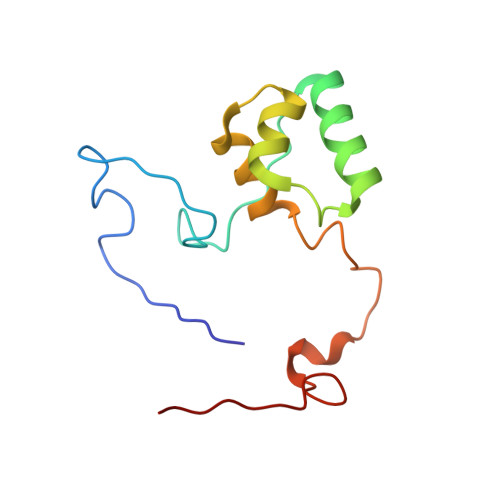Homeodomain-like DNA binding proteins control the haploid-to-diploid transition in Dictyostelium.
Hedgethorne, K., Eustermann, S., Yang, J.C., Ogden, T.E.H., Neuhaus, D., Bloomfield, G.(2017) Sci Adv 3: e1602937-e1602937
- PubMed: 28879231
- DOI: https://doi.org/10.1126/sciadv.1602937
- Primary Citation of Related Structures:
5NR5, 5NR6 - PubMed Abstract:
Homeodomain proteins control the developmental transition between the haploid and diploid phases in several eukaryotic lineages, but it is not known whether this regulatory mechanism reflects the ancestral condition or, instead, convergent evolution. We have characterized the mating-type locus of the amoebozoan Dictyostelium discoideum , which encodes two pairs of small proteins that determine the three mating types of this species; none of these proteins display recognizable homology to known families. We report that the nuclear magnetic resonance structures of two of them, MatA and MatB, contain helix-turn-helix folds flanked by largely disordered amino- and carboxyl-terminal tails. This fold closely resembles that of homeodomain transcription factors, and, like those proteins, MatA and MatB each bind DNA characteristically using the third helix of their folded domains. By constructing chimeric versions containing parts of MatA and MatB, we demonstrate that the carboxyl-terminal tail, not the central DNA binding motif, confers mating specificity, providing mechanistic insight into how a third mating type might have originated. Finally, we show that these homeodomain-like proteins specify zygote function: Hemizygous diploids, formed in crosses between a wild-type strain and a mat null mutant, grow and differentiate identically to haploids. We propose that Dictyostelium MatA and MatB are divergent homeodomain proteins with a conserved function in triggering the haploid-to-diploid transition that can be traced back to the last common ancestor of eukaryotes.
Organizational Affiliation:
MRC Laboratory of Molecular Biology, Francis Crick Avenue, Cambridge CB2 0QH, UK.














